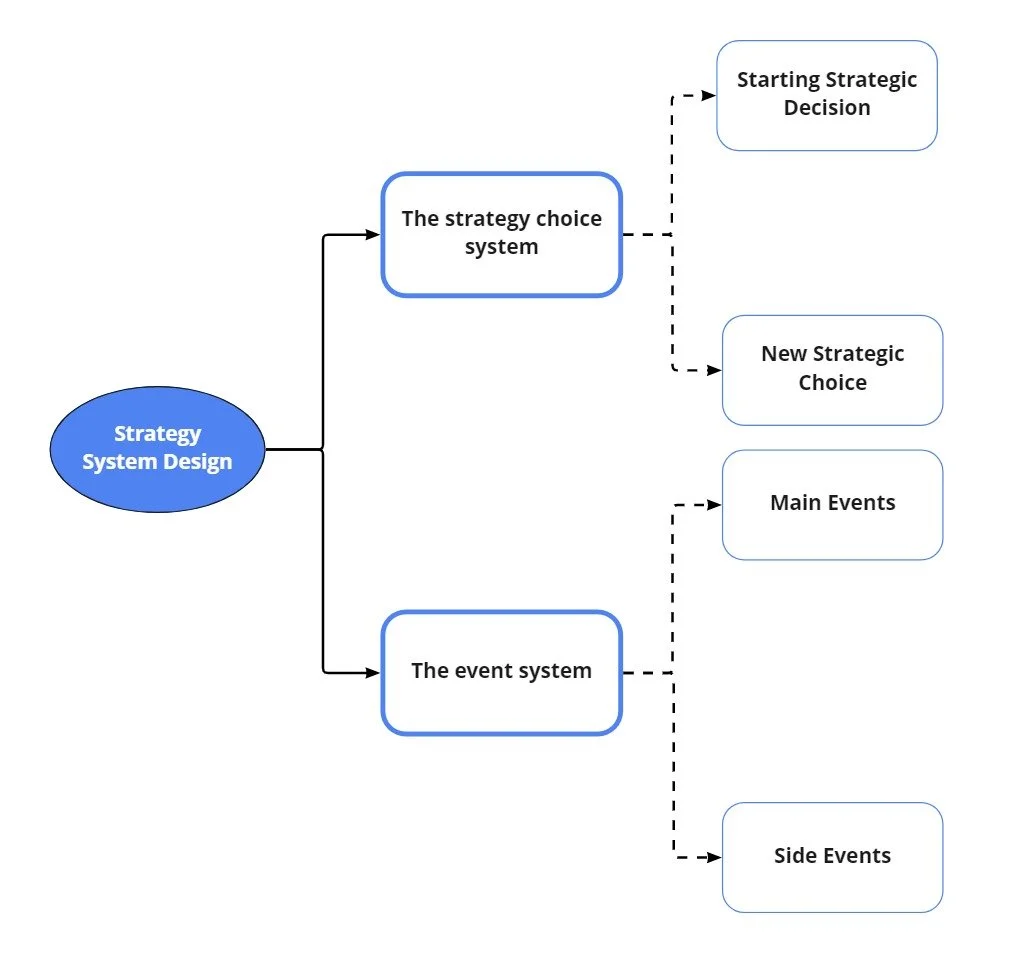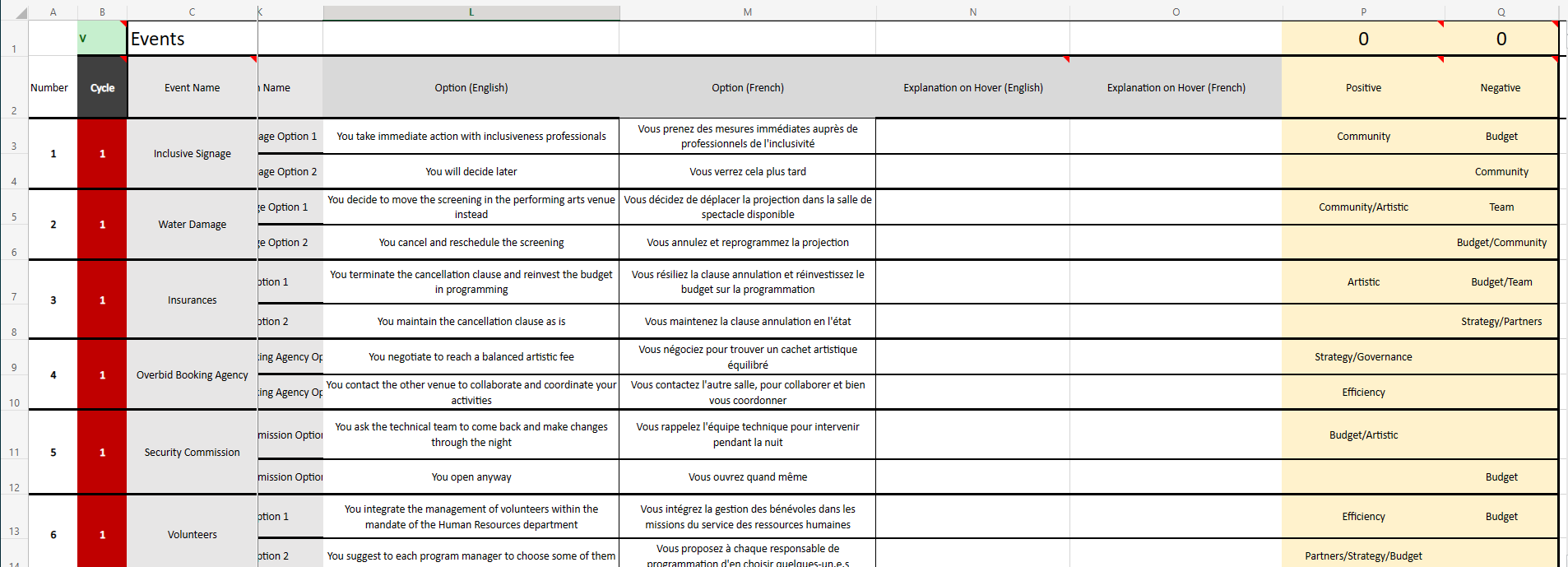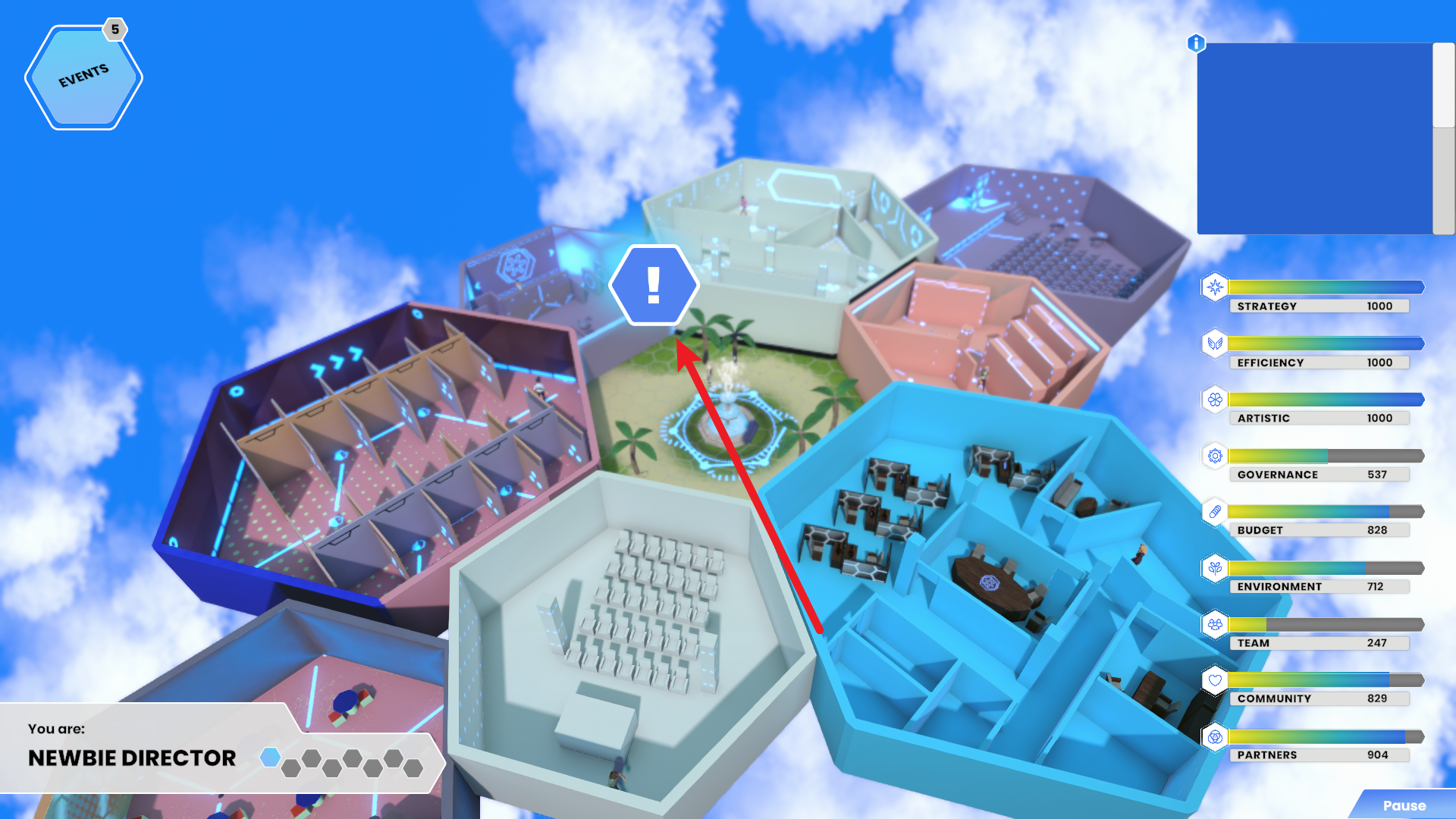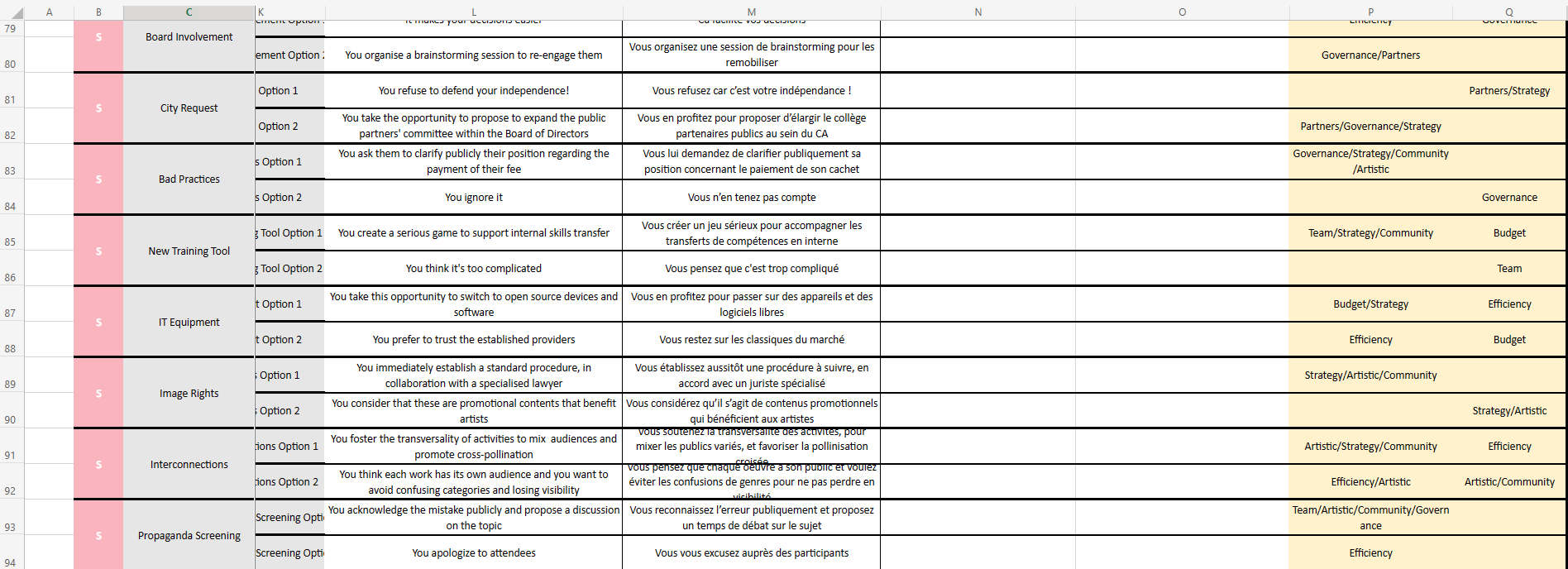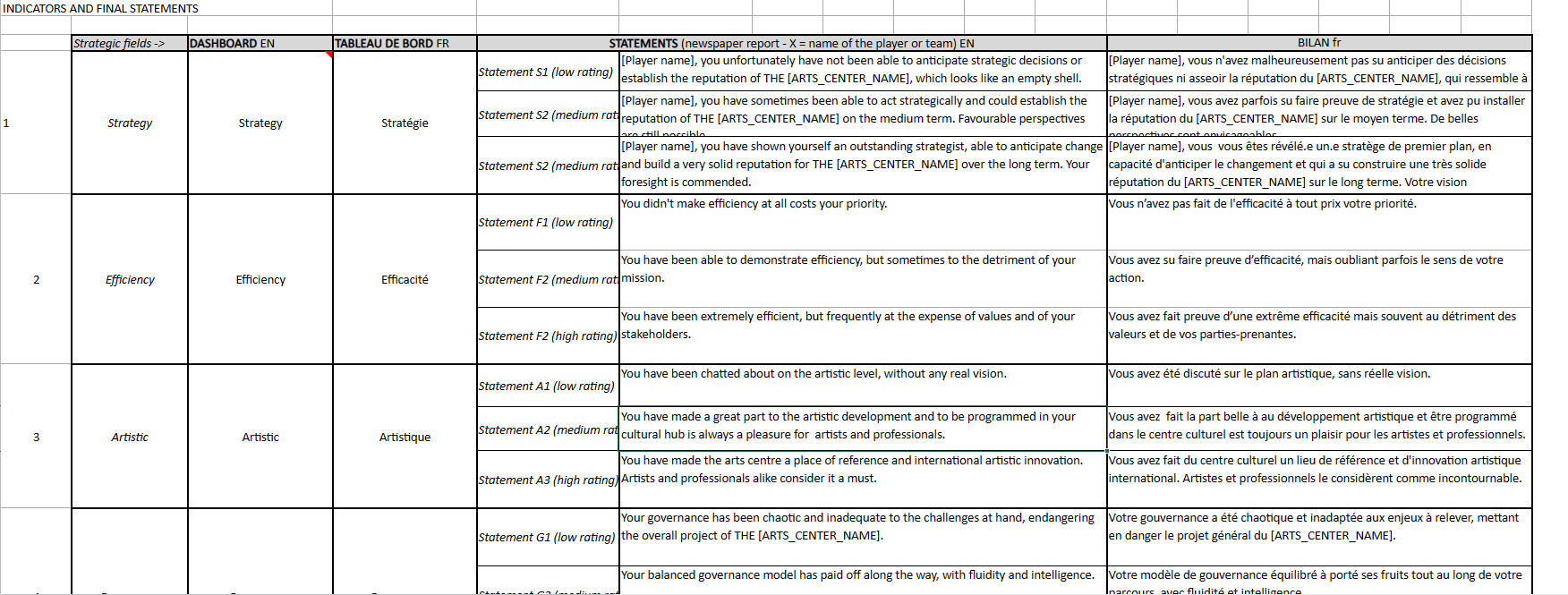is a digital simulation serious game to explore the skills and strategies needed to create and manage future artistic production and presentation venues.
Team
Mars Balisacan, Asher Gao, Kennedy Kan, Sofie Vang Nielsen, Jisoo Shin, Chali Termpaiboon
Platform
Windows, MacOS, HTML5
My Role
Game Designer & UX Designer
Duration
3 Month
Engine
Unity
Genre
Serious Game, Strategic, Simulator, Educational
Target Players
Culture professionals and leaders
Overview
Future Arts Centre is a multi-platform serious strategic simulator game that provides different scenarios and management cycles of a fictional multidisciplinary arts centre.
Players are engaged in strategic decision-making of the cultural space of an art centre, shaping its appeal and relatability to audiences, communities, and stakeholders. As managing an art centre’s operations is never easy, players will need to rely on their resources and cultural understanding of the creative and professional space to be able to address events and issues they might encounter as they progress through the game.
My Duty
On Future Arts Centre, I was Game Designer and UX Designer. My duties included:
Pitch gameplay features and ideas
Designed game system and gameplay mechanics, including event systems with different weights, rewards system, achievement system, and multi-branching endings etc.
Created and filled out spreadsheets of game events system, iterated and updated based on player’s feedback and developer’s technical needs.
Applied Unity engine UGUI capabilities to create game user interfaces
Participated in internal and external playtesting, summarized problems and proposed solutions
Demo Reel
Game Flow
The entire game can be broken down into three large sections:
The beginning:Including basic information introduction and starting strategy decisions
Core game cycle:Including 8 game cycles, each including main events and side events, with an event with social impact and new strategic choice as the end of each cycle
Summary:Including multi-branch endings and achievements for the player
Game System Design
“How to let players feel immersive in the introduction stage of the whole game?”
Considering that the audience for this game is cultural professionals, my design principle is to introduce a familiar scenario for them at the beginning: receiving a job offer, and starting one's work as the director of an art center.
There are two main reasons for this design:
This design is consistent with the real process of people getting hired, reducing the cost of understanding for the player, especially those who have rarely played the game before.
The form of emails and conversations will be more lively and interesting to the player.
“What factors are taken into consideration when designing the game's strategy system”
In the game, the player takes on the role of a newly appointed diretor of an art center. After thorough research, I divided the overall strategy system of the game into two major parts:
The Strategy Choice System
The Event System
The strategy choice system can be divided into two parts: “starting strategic decision” and “new strategic choice”
And the event system can aloso be divided into two parts: “main events“ and “side events”.
When designing the game's strategy system, I first considered "realistic" and "instructive" .I would like to bring the real situations, problems and daily works that cultural professionals face in their real life into the game after proper design. So that when players are playing this game, they can learn something from the game experience and know how to play the role better.
Design of the Strategy Choice System
After completing the introduction phase and formally entering the game, the player will first start with the "Starting Strategy Decision" phase.
As a newly appointed director of an art center, the player needs to choose one of the two options under each theme, and each option will cause a change in the value of the associated indicator, which is visible in real time. After the player confirms all the choices, the game also gives an overall summary at the end to facilitate the player to review the values of the art center from a macro perspective.
From a design point of view, this part of the process serves as a "pre-plan" function in the whole strategy choice system. This session will focus on the player's strategic vision, and by making choices under all five categories, the player will gain a more macro view of how to plan an art center.
The game consists of eight cycles, and at the end of the first seven cycles, a "Event with Soical Impact" will suddenly occur. These events are different, but they all have an impact on the operation of the art center, which requires players to enter the "New Strategic Choice" phase to rearrange a strategy that fits the current situation.
From a design point of view, this part of the process serves as a "adjust promptly" function in the whole strategy choice system. In real life, there is no doubt that the development strategy of an art center needs to be constantly adjusted to follow the changes in society.
Therefore, by designing this part, it can introduce new variables for players, thus allowing them to rethink the strategies they have developed and make adjustments according to the actual situation, which will further enhance the reality of the game and also enrich the players' experience.
Starting Strategy Decision
New Strategic Choice
Design of the Event System
The event system is another large part of the game's strategy system.
Each of the game's eight cycles contains a specific number of main events. Players need to read the event descriptions and then make their own choice between two options, and each option will cause a change in the value of the associated indicator, which is visible in real time.
The two options available to the player are not "good options" or "bad options" in the traditional sense. In other word, there is no "optimal choice".
For example, you choose to invite a foreign researcher to give a high-level conference, then the "Artistic" of the art center will go up, but the “Community” and “Budget” will go down. On the contrary, if you choose to promote a consultation meeting open to everyone, then the the “Community” and “Budget” will increase but the “Artistic” will decrease.
Through this design, I hope to put the choice in the hands of the players, thus really allowing them to weigh and think what arts centres need today to thrive tomorrow.
Design of main events
Unlike the "main event", the "side event" is designed to present unexpected events or emergency in the game.
Main Events
Side Events
From a game designer's perspective, the "main events" is designed to present the regular work of the art center director in the game. Players need to face the big and small decisions that need to be made in the operation of the art center, and make their own choices after understanding the details of the matter.
By their nature, secondary events are usually of a somewhat negative nature, and they all need to be resolved immediately or the game cannot continue.
In terms of trigger method, side events is not fixed as main events. When the value of an indicator falls below one-third, the secondary event corresponding to it will be triggered.
As with the main event, there is also no such thing as a "good option" or a "bad option" for the two options available to the player for the side events. In other words, there is no "best option" either.
Design of side events
“How to show the growth of the player in a visual way?”
In the game, players take on the role of a newly appointed CEO of a brand new art center, making strategic decisions and reacting to global and local events in eight game cycles (over ten years of in-game time). If such a character exists in reality, he/she must be growing and learning from experience during such a long tenure.
So, I first designed a upgrade interface at the end of each game cycle, after the player has rearrange the strategy to react the event with social impact, to tell the player that he has been upgraded and has become a more experienced director.
I mainly start from the UX perspective, by designing different interfaces to reflect the growth of players.
The End of Cycle 1 : Novice Director
The End of Cycle 7 : Legendary Director
Upgrade Interface at the End of Each Game Cycle
Progress Bar at the Main Screen
Then, I also designed the current status progress bar that is always displayed in the bottom right corner of the main game screen.
There are two reasons for this design:
Show the stage the player has reached now, and reflects the player's growth by comparing before and after
Remind players of the overall progress of the game
Cycle 1 : Newbie Director
Cycle 8 : Legendary Director
“Why you choose to design multiple ending system and achievement system?”
In this way, players will play the game several times, alone or with peers, with the mentality of "I'll do better next time" or “I’ll will something different next time”, thus achieving the educational and instructional purpose of the serious game: promote skills development and support the cultural sector in a perspective of ecosystems change.
When the player completes all eight game cycles, the game will enter the ending phrase.
Both systems were designed with a similar goal in mind, which is to improve the replayability of the game.
Ending Statement: Low Efficiency
Ending Statement: Medium Efficiency
Multiple Ends
Achievement System
The achievement system in the game is specifically shown in the form of trophies that players win at the end.
Summary of Trophy that Players Get
Detail Information of the Trophy
The ending will be based on the indicator values, and different values for different indicators will correspond to different ending statements.
In the story of the game, the player, as the director, leaves the art center after more than ten years of hard work. At this time the local newspaper published an article on this, and the game's ending is presented to the player through this form.
There are nine trophies in the game, which correspond to each of the nine indicators in the game. If the value of a certain indicator is in the "HIGH" range at the end, the player will win the corresponding trophy.
Correspondence between indicators and trophies
Requirements to win the trophy
Project Takeaways
Game mechanics are the skeleton of a game, while game content is the flesh and blood of a game. A good game requires a close combination of the two, and the absence of either party in the game design phase will have a huge negative impact on the overall development of the game
When developing a game for a client, you need to allocate sufficient time and workload to deal with unexpected situations from the client's side.
You can't develop a good game without good project management. A good game designer should also learn the skills related to team management and maintain close communication with artists and developers.











